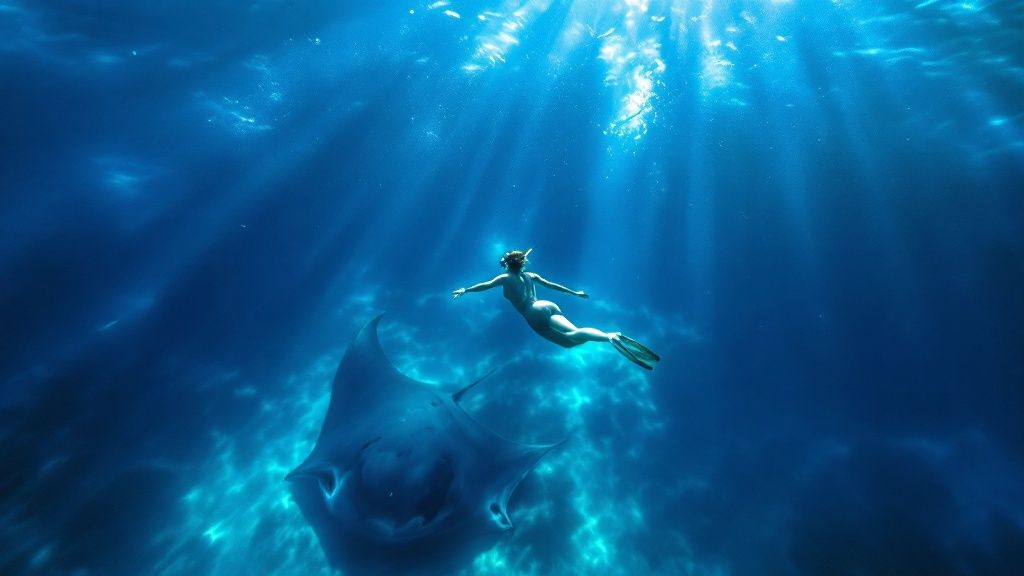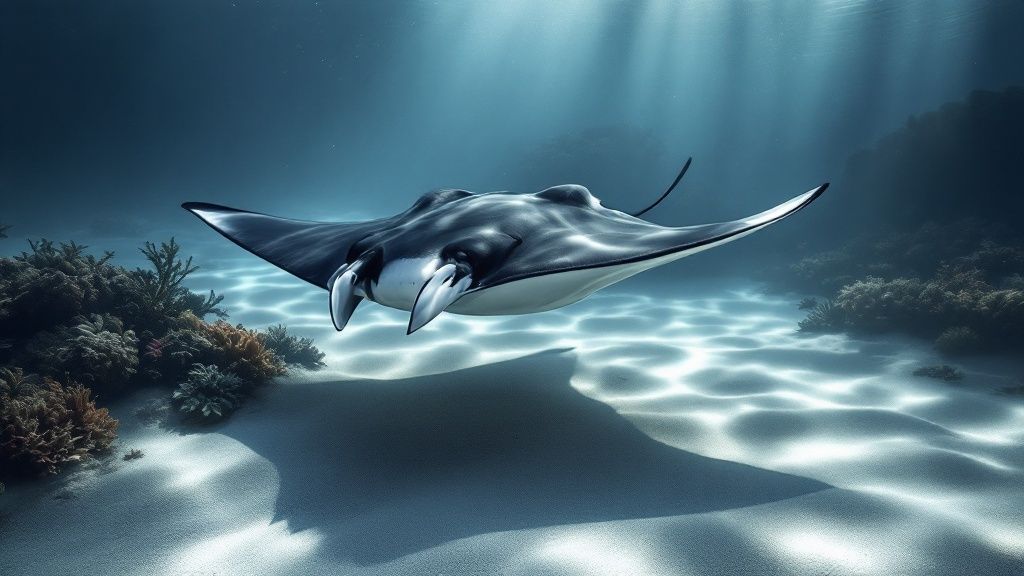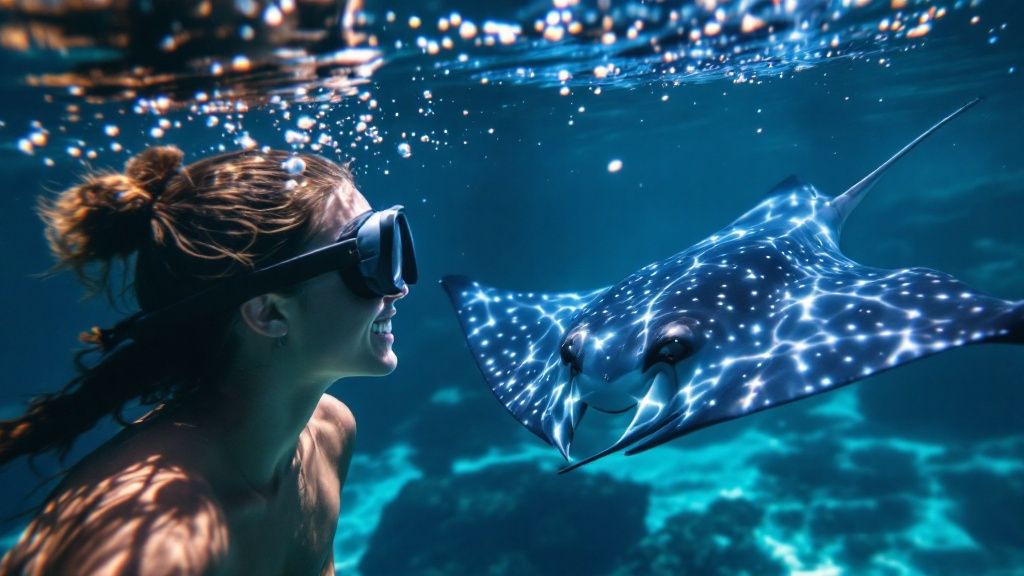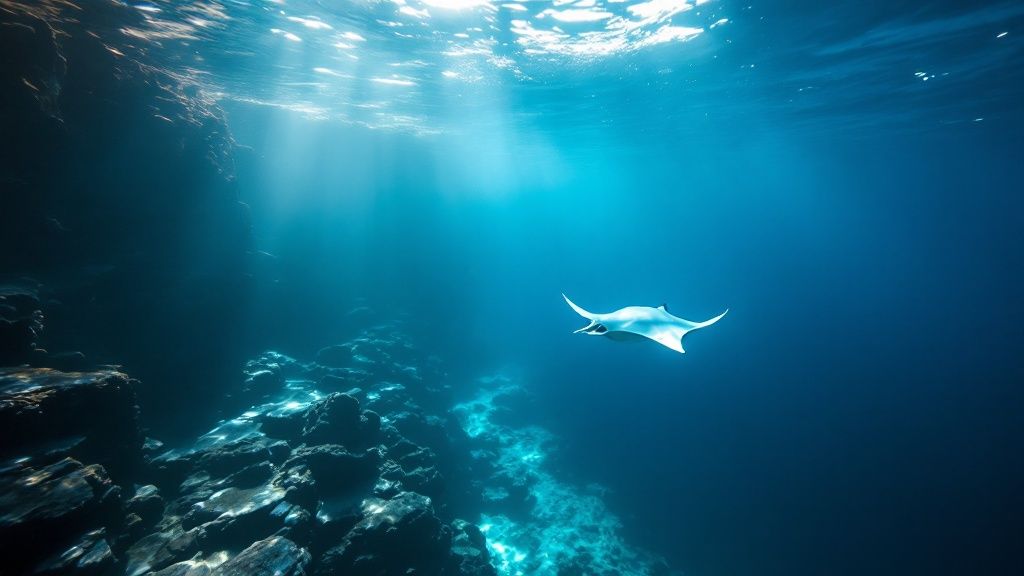The Magic Behind Kona Manta Ray Snorkeling

Kona, Hawaii, is more than just a beautiful island destination; it's a world-renowned location for encountering manta rays. These graceful giants of the ocean draw visitors and scientists alike, creating a unique blend of scientific discovery and unforgettable tourist experiences. What makes Kona so special for manta ray snorkeling?
The Kona Manta Ray Ecosystem: A Perfect Harmony
The magic lies in the unique ecosystem. Nutrient-rich currents flow along the Kona coast, bringing with them microscopic plankton, the main food source for manta rays. These currents, combined with Kona's underwater volcanic slopes and plateaus, create a perfect feeding ground. The underwater topography acts like a natural funnel, concentrating the plankton and making it easier for the manta rays to dine.
Nighttime Feeding Spectacle: A Ballet of Giants
Manta rays are expertly adapted to feed at night. As darkness falls, tour operators use underwater lights, mimicking the moon's glow, which attracts plankton to the surface. This creates a "plankton buffet," drawing in the manta rays and allowing snorkelers to witness their captivating feeding rituals. The manta rays' slow, graceful movements as they filter the plankton-rich water is a truly breathtaking sight.
Tourism and Conservation: A Symbiotic Relationship
This natural phenomenon has made Kona manta ray snorkeling a popular activity. Kona attracts approximately 80,000 manta ray snorkelers annually, boasting an 85-90% sighting success rate year-round. This is largely due to the consistent presence of manta rays, drawn to the abundant plankton. Learn more about Manta Ray Snorkeling in Kona.
This influx of visitors not only brings economic benefits to the area but also promotes awareness about the importance of manta ray conservation. Responsible tourism can play a vital role in protecting these gentle giants and their delicate ecosystem. The magic of Kona's manta rays continues to inspire awe and wonder, making each snorkeling trip a potential opportunity for positive change.
Prime Locations for Unforgettable Manta Encounters

Kona's nutrient-rich waters and unique underwater topography create a haven for plankton, drawing in the majestic manta rays. This makes Kona a prime location for manta ray snorkeling. However, some spots offer even more consistent and spectacular encounters. Knowing the distinct characteristics of each site can truly elevate your experience.
Manta Village: The Nightly Show
Perhaps the most renowned spot is Manta Village, nestled within Keauhou Bay. Its shallow, sandy bottom and abundant plankton make it a predictable feeding ground for manta rays. Picture a vast, underwater amphitheater where these gentle giants put on a nightly show. During peak season, sightings at Manta Village are almost guaranteed.
Garden Eel Cove: Up Close and Personal
If you're seeking a more intimate encounter, Garden Eel Cove is an excellent choice. While less famous than Manta Village, it offers a unique underwater landscape. Gentle slopes and crevices provide shelter for both manta rays and garden eels, creating opportunities for a truly special snorkeling experience. You might even witness these two fascinating creatures interacting in close proximity.
Keauhou Bay: A Diverse Ecosystem
Keauhou Bay, home to Manta Village, offers a variety of manta ray viewing spots. Each location provides a slightly different perspective, catering to various skill levels. Some areas boast shallow depths, perfect for beginners, while others offer deeper waters for more experienced snorkelers. This diversity makes Keauhou Bay an ideal destination for anyone wanting to witness these magnificent creatures.
Exploring Beyond the Beaten Path
While popular locations offer reliable sightings, venturing off the beaten path can provide a more personalized and unique adventure. Experienced guides often lead small groups to these hidden gems, allowing for intimate encounters with manta rays in less crowded settings. This offers a deeper connection with the animals and their ocean environment.
Research conducted in 2013, focusing on areas like Manta Village and Manta Heaven, revealed remarkably consistent manta ray sightings during both night dives and snorkeling trips. Find more detailed statistics here. The unique geological features of these locations continue to support the manta rays' feeding habits, ensuring thriving populations.
The following table provides a comparison of the top manta ray snorkeling locations in Kona:
Top Kona Manta Ray Snorkeling Locations: Comparison of the main manta ray viewing sites around Kona, including success rates, accessibility, and unique features.
Location | Success Rate | Best Time | Depth | Special Features |
|---|---|---|---|---|
Manta Village | Very High | Night | Shallow | Sandy bottom, predictable feeding ground |
Garden Eel Cove | High | Night | Varies | Unique terrain, garden eels |
Other Keauhou Bay spots | High | Night | Varies | Diverse depths for all skill levels |
Off-the-beaten-path locations | Varies | Depends on location | Varies | Intimate encounters, less crowded |
This table highlights the variety of snorkeling experiences available in Kona, showcasing the unique features of each location. Whether you're a beginner or an experienced snorkeler, there's a perfect spot for you to witness the majestic manta rays. For further reading, you might be interested in: Our sitemap for more information on related topics.
Preparing for Manta Magic: Essential Know-How

Getting ready for an extraordinary Kona manta ray snorkeling adventure starts with the right preparation. This means picking the perfect tour operator, having the essential gear, and knowing how to stay comfortable and calm in the water. These steps will maximize your chances of an unforgettable close encounter.
Choosing a Responsible Tour Operator
Finding a responsible tour operator is crucial for an ethical and enriching experience. Prioritize operators dedicated to sustainable practices, like adhering to strict viewing guidelines and participating in conservation efforts. Some operators even donate to manta ray research and protection, which is a great sign.
Also, consider group size. Smaller groups often mean more personalized attention from the guides and less disturbance to the manta rays. Experienced guides knowledgeable about manta ray behavior are essential for both your safety and the well-being of these gentle giants.
Essential Equipment for an Enhanced Experience
The right gear can significantly enhance your manta ray snorkeling adventure. A wetsuit is key for comfort, especially during night excursions when the water gets colder. It keeps you warm so you can focus on the manta rays, not on shivering.
Many operators provide pool noodles for buoyancy. These are helpful for less confident swimmers and also minimize kicking, which can disturb the manta rays. If you bring your own snorkel gear, ensure it fits properly for maximum comfort and enjoyment.
Maximizing Comfort and Calmness in the Water
Staying calm and relaxed in the water is essential for attracting manta rays. These creatures are sensitive to excessive splashing and erratic movements. Think of yourself as a guest in their underwater home.
Enter the water slowly and deliberately, minimizing splashing. Control your breathing – deep, steady breaths will help regulate your buoyancy and create a sense of calm. This calmness extends to photography as well. Avoid frantic movements and flashing lights, which can startle the manta rays.
If you feel nervous, talk to your guide. They are there to support and reassure you, ensuring a positive and safe experience. For more tips on ocean adventures, check out our blog post sitemap.
Pre-Excursion Preparations for a Smooth Adventure
Preparing for your Kona manta ray snorkeling trip goes beyond just showing up at the dock. If you're prone to seasickness, taking motion sickness medication beforehand is a smart move. This can prevent discomfort and allow you to fully enjoy the experience.
Dressing in layers before and after your snorkel is a good idea, as evening temperatures can change. Finally, review the operator's guidelines and recommendations. They often provide valuable insights into what to expect and how to best prepare for a truly memorable encounter with these magnificent creatures.
Hawaiian Cultural Connections With Hahalua (Manta Rays)

Beyond the sheer thrill of Kona manta ray snorkeling lies a deeper, more profound connection to Hawaiian culture. These magnificent creatures, called hahalua in the Hawaiian language, hold a place of honor in the islands' history, legends, and spiritual beliefs. Understanding this rich cultural context elevates the snorkeling experience from simple observation to a truly meaningful encounter.
Hahalua in Hawaiian Folklore and Traditions
For countless generations, Hawaiians have revered the manta ray. Its graceful, almost ethereal movements and gentle nature have inspired countless stories and chants, carefully preserved and passed down through oral traditions. Some legends portray hahalua as guardians or messengers, embodying ancient wisdom and a deep connection to the spiritual realm. These stories often underscore the interconnectedness of all living things, a fundamental principle of Hawaiian cosmology.
Traditional Ecological Knowledge and Modern Science
Traditional Hawaiian ecological knowledge (TEK) offers invaluable insights into the behavior and ecology of manta rays. This accumulated wisdom, gleaned from centuries of careful observation, often complements and enriches modern scientific understanding. For instance, TEK highlights the crucial importance of specific locations for manta ray feeding and breeding, providing vital information that can inform and enhance conservation efforts. This harmonious blending of ancient wisdom and contemporary research paints a richer, more holistic picture of these captivating ocean dwellers.
Respectful Operators: Incorporating Cultural Protocols
The cultural significance of manta rays in Kona adds another dimension to the snorkeling experience. Revered for their grace and intelligence, these creatures occupy a special place in Hawaiian folklore and traditions. This cultural reverence transforms the snorkeling adventure into something truly special, a meaningful encounter that connects visitors with the local respect for these animals while they witness their breathtaking underwater ballet. Learn more about this cultural connection. Many responsible tour operators thoughtfully incorporate cultural protocols into their excursions. This might include sharing traditional stories about hahalua, explaining their vital role in the delicate ecosystem, or observing quiet moments of silence and respect before entering the water.
A Deeper Connection to Hawaii's Living Culture
By understanding the cultural context of Kona manta ray snorkeling, visitors cultivate a deeper appreciation for Hawaii's vibrant and evolving cultural landscape. This deeper understanding fosters respect for the environment and strengthens the profound connection between humans and the natural world. This isn't simply about seeing manta rays; it's about experiencing them within a rich cultural tapestry that elevates and enriches the entire adventure. Our sitemap offers additional resources for those who wish to delve deeper.
Beyond Tourism: Conservation Impact of Your Adventure
Your Kona manta ray snorkeling adventure offers more than just an incredible personal experience. It directly contributes to vital manta ray research and conservation efforts across the globe. This model of responsible tourism helps safeguard these gentle giants for generations to come.
Citizen Science: Your Photos Make a Difference
Every photo taken during your Kona manta ray snorkeling trip can become a valuable scientific tool. Many operators encourage guests to submit their photos to international manta ray identification databases. These databases rely on the unique spot patterns on each manta's underside, much like a human fingerprint, to track individuals, monitor their health, and study their migration patterns.
This means your vacation snapshots can play a crucial role in understanding and preserving these amazing animals. Imagine, your photos could help scientists unlock key secrets about manta ray behavior!
Tracking Migrations and Population Trends: Power in Numbers
Beyond photographs, reported sightings from Kona manta ray snorkeling excursions provide crucial data. This information helps researchers track manta ray movements, understand their habitat use, and monitor population trends.
For example, data collected by Manta Ray Advocates in Kona between 2009 and 2014 provided vital insights into manta behavior and population fluctuations. This included which individual mantas were sighted and their physical condition, aiding in understanding their movements and predicting periods of higher manta presence. Find more detailed statistics here. This demonstrates the power of citizen science in conservation.
Funding Conservation: Your Dollars at Work
The fees you pay for your Kona manta ray snorkeling excursion often directly support conservation initiatives. Responsible operators invest a portion of their profits into research, education, and advocacy efforts that benefit manta ray populations.
This means your tourism dollars help fund critical work to protect these animals and their delicate ecosystem. This makes choosing an ethical operator even more important. You might be interested in: Our sitemap which features more information about our sustainable practices.
Greenwashing vs. Genuine Conservation: Spotting the Difference
It's crucial to distinguish between greenwashing, where companies misleadingly promote their environmental efforts, and genuinely committed operators. Look for certifications, partnerships with recognized conservation organizations, and transparent information about how visitor fees contribute to specific projects.
Choose operators who prioritize sustainable practices and actively participate in manta ray protection. Doing your research ensures your trip has a truly positive impact.
Threats to Hawaii's Mantas: Understanding the Challenges
Hawaii's manta rays face multiple threats, including entanglement in fishing gear, habitat degradation, and the impacts of climate change. By participating in responsible Kona manta ray snorkeling, you directly support efforts to combat these challenges.
For example, responsible tour operators advocate for stricter fishing regulations to reduce bycatch and educate the public about responsible interactions with manta rays. Your support makes a real difference in preserving these gentle giants for future generations. Understanding these threats empowers you to make informed choices about your Kona manta ray snorkeling experience, ensuring your adventure contributes to a future where these magnificent creatures continue to flourish.
Insider Secrets for Extraordinary Manta Encounters
Kona manta ray snorkeling is an amazing experience. But going beyond the typical tourist encounter can lead to some truly special moments. This involves understanding manta ray behavior and using smart timing and positioning to enhance your viewing.
Timing Is Everything: Moon Phases and Plankton Blooms
Just like seasoned fishermen track tides, experienced manta ray guides understand the importance of timing. The lunar cycle significantly affects plankton availability, the manta rays' main food source. Around the full moon, increased moonlight attracts more plankton to the surface. This creates a feeding frenzy that draws in many mantas.
Seasonal plankton blooms also create periods of exceptional manta ray activity. These blooms happen at different times of the year. Checking with local operators or online resources can help you pinpoint the best time for your Kona manta ray snorkeling adventure.
Positioning for the Perfect View: The Art of Subtlety
Imagine being a guest in the manta rays' underwater home. Your behavior affects their comfort level. Avoid sudden movements and splashing, which can frighten the mantas. Maintain a horizontal position in the water, minimizing vertical kicking that might disrupt their feeding.
Positioning yourself slightly away from the main light source, but still within viewing distance, can encourage closer approaches. Manta rays are curious and often approach snorkelers who appear calm and non-threatening. For more tips, check out our blog post sitemap for responsible snorkeling practices.
Common Mistakes That Repel Manta Rays: What Not to Do
Many snorkelers are eager for close encounters, but certain actions can scare away manta rays. Touching them is never allowed, as this disrupts their delicate mucous layer, which is vital for their immune system. Flash photography can also startle them, causing them to swim off.
Chasing manta rays is also counterproductive. They are more likely to approach snorkelers patiently observing from a respectful distance. It's similar to birdwatching – the quieter and calmer you are, the better your viewing opportunities.
Mental Preparation: Being Present in the Moment
Beyond the physical preparation, mental readiness enhances your experience. Before entering the water, take a moment to focus on your breathing and relax your body. This reduces anxiety and lets you fully appreciate the magical encounter.
Instead of focusing only on getting the perfect photo, try to absorb the moment. Remember the feeling of weightlessness, the graceful manta ray movements, and the ethereal glow of the underwater lights. These sensory details create lasting memories.
Seasonal Manta Ray Viewing Guide
The following table provides a general overview of manta ray activity and conditions throughout the year in Kona.
Month | Manta Activity | Water Visibility | Water Temperature | Crowd Level |
|---|---|---|---|---|
January | Moderate | Good | Cooler | Moderate |
February | Moderate | Good | Cooler | Moderate |
March | Increasing | Good | Starting to warm | Increasing |
April | High | Very Good | Warmer | High |
May | High | Very Good | Warmer | High |
June | High | Excellent | Warmest | High |
July | High | Excellent | Warmest | High |
August | High | Excellent | Warmest | High |
September | High | Excellent | Starting to cool | High |
October | Moderate | Very Good | Cooler | Moderate |
November | Moderate | Good | Cooler | Moderate |
December | Moderate | Good | Cooler | Moderate |
This table helps you start planning your Kona manta ray snorkeling trip. These are general trends, and actual conditions can vary. Contacting local operators is always recommended for the most up-to-date information.
Essential Questions Answered by Manta Ray Experts
Kona manta ray snorkeling is an exciting adventure, but it's natural to have questions. This section addresses common inquiries, providing clear answers based on visitor experiences and expert advice to help you prepare for your manta ray encounter.
Addressing Concerns for All Snorkelers
Many people wonder, "Do I need to be a strong swimmer for Kona manta ray snorkeling?" The answer is reassuring: basic swimming skills are recommended, but even less confident swimmers can participate. Flotation devices like pool noodles are commonly provided, allowing you to relax and observe the manta rays without strenuous effort. Some tours even cater specifically to non-swimmers, offering viewing opportunities from the boat.
Safety in the Water: Separating Fact From Fiction
Safety is paramount. Experienced guides prioritize your well-being and the manta rays' protection. They provide thorough safety briefings, explain proper snorkeling etiquette, and stay close to the group. Manta rays are gentle giants and pose no threat to humans when treated with respect.
Weather Conditions and Sightings: Truth vs. Excuses
How does weather affect sightings? While severe storms can lead to cancellations, moderate conditions rarely impact visibility or manta ray activity. Some less reputable operators might use weather as an excuse for poor sightings. Choose a company with a "manta ray guaranteed" policy for a second chance if your initial trip is unsuccessful.
Accommodations for Physical Limitations: Ensuring Accessibility
Reputable tour operators strive to accommodate various needs and limitations. They provide support and adapt procedures as necessary. Contact the operator directly to discuss specific requirements and ensure a comfortable and enjoyable experience.
Encounter Proximity and Seasickness: Managing Expectations
While close encounters are common, they aren't guaranteed. Manta rays are wild animals with unpredictable behavior. For those prone to seasickness, preemptive medication is highly recommended. The boat's gentle rocking, combined with nighttime conditions, can sometimes trigger nausea.
Ecological Impact: Choosing Responsible Tourism
Consider the ecological impact of your adventure. Choose operators committed to sustainable practices, such as those with certifications or partnerships with conservation organizations. This ensures your Kona manta ray snorkeling adventure aligns with responsible wildlife tourism, benefiting both you and these magnificent creatures.
Comentários